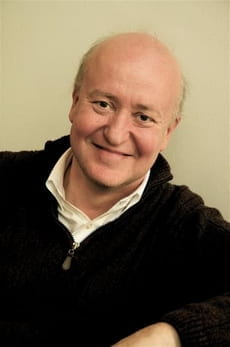 The impact of social media and changing audiences were primary concerns of arts journalists and leaders of cultural institutions who gathered at a Communication Leadership Policy Forum at the University of Southern California’s Washington, D.C. Center on August 1.
The impact of social media and changing audiences were primary concerns of arts journalists and leaders of cultural institutions who gathered at a Communication Leadership Policy Forum at the University of Southern California’s Washington, D.C. Center on August 1.
“Arts journalism is struggling for its life,” said Jaime Bennett of the National Endowment for the Arts. “It’s no surprise that journalists are taking to the blogosphere to share their reviews.”
Organized by senior fellow Adam Clayton Powell III (pictured right) and Tim Page, the USC Annenberg journalism professor and Pulitzer Prize-winning former music critic for The Washington Post, the forum focused on the impact of social media on how news is written and reviews are shared with audiences.
Page expressed concern that some reviewers now send Twitter messages during intermissions and even in mid-performance. But he added this may not be entirely new, because reviewers of long operas often cannot stay for the last act if they are to meet their newspaper deadlines.
Jessica Goldstein, arts reporter for The Washington Post, stated that building an audience across social media is now a requirement of her job. “The Washington Post wants me tweeting. It’s an aspect of brand cultivation.”
“Social media helps for the organization to spread reviews,” added Bennett. “It’s just as important for a newspaper or organization to utilize these tools as it is for the actual journalists.”
With the pace of technological innovation increasing almost daily, the future of media is unclear, and the reporters and writers who have experienced some of the greatest uncertainty are arts journalists.
Susan Clampitt, former executive director of WAMU-FM and now a member of the District of Columbia Commission on the Arts and Humanities, described a new role of arts journalism. “The role of a critic is to stimulate discussion about a work. You want your readers to have enough engagement to have an honest response. As a journalist, my opinions are not the most important but it should help to stimulate the conversation and keep it going.”
Washington Post classical music critic Anne Midgette also echoed Clampitt’s sentiments. “I think the democratization that arts journalism has brought is a welcome change.” Midgette made the comparison of crowd sourcing arts reviews akin to reading customer reviews on Amazon. It has become easier for audience to read short reviews or recommendations from others on new projects that might be of similar interest.
“We need to be able to harness the initial enthusiasm that we see in young children for the arts,” continued Midgette, “And stop relying on what the ‘important people’ are saying about a particular piece.”
Felix Contreras of the NPR Arts Desk recognizes social media as a game changer in terms of all areas of journalism. “We all work for a newspaper or an organization, but now we could very easily go out and start our own blogs, and many of us do and are.”
“I feel that blogs and social media can open the door to many people interested in classical music who feel they are not educated enough about the topic,” said Thomas Huizenga of NPR Music. “They can easily express opinions and learn more by commenting on blog posts or lurking in places like chat rooms during live concert webcasts.”
Many cultural institutions now bypass arts journalism entirely, according to Chad Bauman, director of communications at Washington’s Arena Stage.
“I can press a button and reach a million people,” said Bauman, referring to a new electronic messaging network Arena Stage has created.
Dorothy Kosinski, director of The Phillips Collection, agreed, saying that partnerships and the “nimble” use of electronic promotions across social networks are critical to creating audiences for the Phillips. One partnership alone, with the DC Jazz Festival, attracted 5,000 people to a weekend of jazz concerts in the Phillips galleries, according to Kosinski.
Karen Christensen, chair of the Tucson Pima Arts Council, said that arts journalists may face difficulties in Los Angeles, New York or Washington, but the situation is dire in some smaller cities, describing recent layoffs at Tucson’s newspaper that all but eliminated staff coverage of the arts. And Christensen expressed concern that in “fly-over country,” arts journalism and arts organizations face financial difficulties.
This discussion is part of an ongoing series bringing together policymakers, journalists, nonprofit organization leaders, and researchers to examine important issues in communication, leadership and policy. The series, organized by Powell, will continue throughout the year in Washington and Los Angeles.